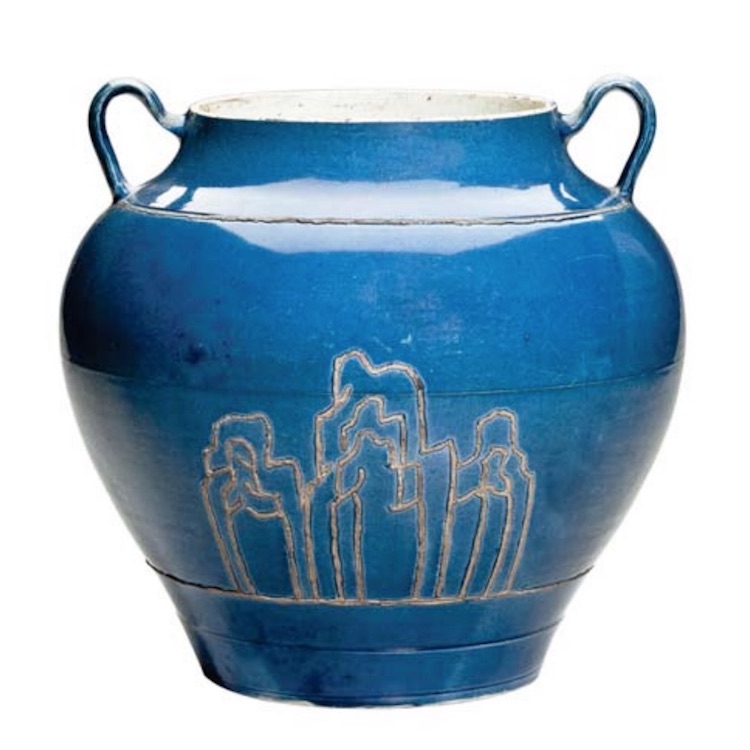NEW YORK — On exhibition at Bard Graduate Center is Design by the Book: Chinese Ritual Objects and the Sanli tu, which examines a medieval Chinese book that is the oldest extant illustrated study of classical Chinese artifacts like ceramic sacrificial vessels (March 24 – July 30, 2017).
Featured image: Mountain Jar. China, Ming dynasty, Jiajing mark and period, 1522–1567. Porcelain. Private collection.

Catalogue cover.
The exhibition features a number of artifacts, juxtaposed against the pertinent entries of the ‘Sanli tu,’ many of which have never been on public view. These include a Qing-dynasty (1644-1912) chime stone, dated 1716; bronze ritual vessels, from the Metropolitan Museum of Art; and a sixteenth-century blue ceramic jar likely made for the Ming Sacrifice to Heaven (featured above). A rare example of a costume made for the last Sacrifice to Heaven (pictured below), performed in 1914 by President Yuan Shikai, from the Jordan Schnitzer Museum of Art at the University of Oregon, is also on view.

Exhibition view.

Exhibition view.

The ‘Sanli tu’ (also known as Illustrations to the Ritual Classics) is a little-known medieval book that holds a key place in the history of Chinese material culture studies. Functioning much like an encyclopedic addendum, it is the oldest illustrated study of classical Chinese ritual implements offering 362 illustrated entries on artifacts, buildings and concepts mentioned in the Ritual Classics (c. 5th – 3rd century BCE), part of the Confucian canon, a collection of texts laying out the rules and rationales of classical ritual.

First compiled in the second century CE, the ‘Sanli tu’ comes down to the center in its sixth incarnation, which was produced by a classics professor named Nie Chongyi in 961, the second year of the Song dynasty (960–1279). Nie’s book not only explained the ceremonial objects described in the ancient Confucian canon, but it also served as a basis for designing new ritual objects, such as clothing, musical instruments and sacrificial vessels for imperial state rites like the Sacrifice to Heaven, to mourning and burial paraphernalia for the court and the educated elite.

For the Song dynasty, which was founded on the principles of Confucian morality, the book was of major cultural and political importance. It was first printed under imperial orders and widely promoted in schools from the tenth century onward. The concept of ritual (li), as found the Ritual Classics, encompassed not only rites but also etiquette and proper conduct according to rank and station. Confucian scholars promoted li as one of the guiding principles of their philosophical doctrine. They touted it as the superior means for organizing the state and society, promising not only divine blessings but also social order and peace.

Wine Cup with Cover, Vessel: Late Shang–Early Zhou dynasty, ca. 1200–1000 BCE Cover: Qing dynasty, 1644–1911. Bronze. The Metropolitan Museum of Art, Rogers Fund, 1943 (43.27.1a, b). Image copyright © The Metropolitan Museum of Art. Image source: Art Resource, NY.
Nie’s ‘Sanli tu’ survives today only in monochrome printed editions. The original manuscript of 961 took the form of scrolls and included color illustrations executed by professional painters. These images were subsequently copied onto the walls of several buildings in the Imperial Academy and many local schools throughout the country.

Exhibition view.
The exhibition, curated by François Louis, Associate Professor of History of Chinese Art and Material Culture, is part of of the center’s Focus Projects, which are a central component of the institution’s research, teaching and exhibition program. Focus Projects are developed and curated by faculty and visiting fellows in collaboration with students. Conceived by Dean Peter N. Miller with director of the Gallery, Nina Stritzler-Levine, Focus Projects are headed by professor and curator Ivan Gaskell, who explains, “Bard Graduate Center is a nimble institution, where the ambitions—of students, of curators, of faculty—can actually be realized through Focus Projects that provide a laboratory in which to test theories empirically and to present them functionally to a broader audience.”
Text (edited) from Bard Graduate Center.
Do you love or loathe this exhibition from the worlds of contemporary ceramic art and contemporary ceramics? Let us know in the comments.

Add your valued opinion to this post.